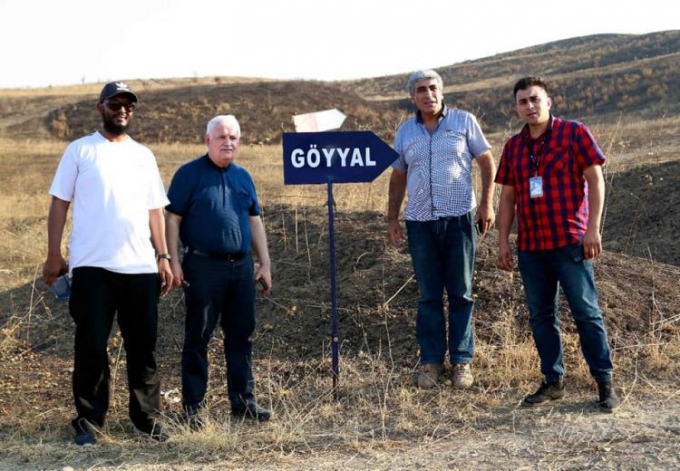As reported, a delegation of Al Jazeera Media Network, organised by the International Eurasia Press Fund (IEPF), visited Gubadli on August 7. The delegation was led by Sami Al-Hajj, Director of the Centre for Human Rights and Public Libertes at Al Jazeera Media Network. Accompanied by IEPF President Umud Mirzayev, the visit was also attended by employees of the Istanbul branch of Al Jazeera Media Network Selahattin Kadirlioglu, Yilmaz Akinci, Omar Alhacc Hazza, Ozugur Mehmet Hayri, Siyam Nidal Bilgay, Eregizli Erhan. Part of the Al Jazeera crew began filming in the Fizuli region on August 5. Then, together with the rest of the delegation, they visited Shusha, Jabrayil, Gubadli, Zangilan districts.
Umud Mirzayev shared his impressions the visit in Gubadli district on his Facebook page.
Sami Al-Hajj, director of the Centre for Human Rights and Public Liberties at Al-Jazeera Media Network, who has been detained in Guantanamo Bay Detention Camp for 2330 days, is on the visit in the village of Goyyal in the Gubadli region.
We have been friends with Sami Al-Hajj, who is known in the world media for his legendary biography. This friendship began with a letter he once wrote to me. Later, we met in person at the World Congress of the International Press Institute in Cape Town. At that time, I was a member of the Board of Directors of the IPI. Among the new members admitted to the Board of Directors of the World Congress was Sami Al-Hajj, a representative of Al Jazeera Media Network, who was accepted with my letter of guarantee. Here he and I got to know each other better. Sami Al-Hajj told me the life story of an Azerbaijani woman he married in 1997.
The parents of her husband Aygul, who was born and raised in the Gafan region of Armenia, are originally from the village of Goyyal in the Gubadli region. Her father, Isa Ismayilov, worked as a machinist on the Baku-Gafan railway. In the late 1980s, she and her family drove a train to Baku, ignoring Armenian threats and insults. Shortly afterwards, Isa Ismayilov's Fatherland Goyyal, like other villages and towns in Karabakh, was occupied. After that, Isa's family had to settle in Baku. Sami Al-Hajj, who later came to Baku for a walk, also met Aygul here and got married. He has one daughter and five sons.
During the 24 years they have lived together, Sami Al-Hajj and Aygul have passed great exams. Aygul also experienced the pain of Sami Al-Hajj's 2,330 days in Guantanamo Bay, minute by minute, hour by hour, and struggled for Sami's release, enduring all the hardships abroad. Sami al-Hajj, who was tortured being innocent at Guantanamo Bay, was released in 2008 thanks to the joint efforts of the Al Jazeera Media Network, international media organizations, and freedom of speech and human rights organizations.
Sami Al-Hajj is currently the head of the Centre for Human Rights and Public Liberties at Al Jazeera Media Network. Today, he has become one of the symbols of Al Jazeera with his legendary biography. Al Jazeera's Doha headquarters also houses a museum of Sami al-Hajj's life at Guantanamo Bay Detention Camp. All dignitaries visiting Al Jazeera pass through this museum. In the last ten years, I have visited that museum named after Sami Al-Hajj many times. Each time, I have new impressions about this man, who has become a living statue of Human Rights and Freedom of Speech.
The IEPF, of which I am the president today, works very closely with the Al Jazeera Media Network. We have many friends in Al Jazeera Media Network. I am very proud that we participated in the vast majority of their visits to our country and region. The IEPF also has a special role in organizing a series of professional and security trainings for Azerbaijani journalists conducted by Al Jazeera Media Network trainers.
After the security exercises, we, together with the Al Jazeera delegation, visited the liberated Fizuli, Shusha, Jabrayil, Zangilan and Gubadli regions of Karabakh in accordance with the program. Visitors who saw the looted territories, cities, villages and temples did not hide their horror, saying that all that was a crime against humanity. Our most exciting and shocking visit was to Goyyal village of Gubadli district. The village where the mother of Sami al-Hajj's children is originally from. Sami Al-Hajjla has previously visited the Karabakh region. But this time it was clear that this trip was a special one for Sami. Sami Al-Hajj went to the village of Goyyal as if he was going to the holiest temple in the world. No matter how hard he tried along the way, he could not hide his feelings and emotions.
After a long journey, we finally arrived in the village. Our car was moving inside the ruined village of Goyyal. As he passed a destroyed house, Sami al-Hajj told the driver, "Stop the car, this is Isa Ismayilov's house." After that, our writer friend Khanamir, who guided us and grew up in these places, immediately expressed his surprise, saying, "Yes, there is, this is really the house of Isa."
We stopped the car and approached the house that was ruined. Sami looked around the yard, stroking the stone walls of the destroyed house with his hands. It was as if these places were no stranger to him. Perhaps that is why he was so shocked by what he saw. Apparently, he was responsible for all this, and did not want to leave the village. I reminded him of the distance and that we were late. After that, we took some soil from the yard of the house and water from a nearby spring and moved to Baku.
... Regardless of which direction we go, my observations give grounds to say that all road were leading to Karabakh's Goyyal for Sami Al-Hajj.
.jpg)
.jpg)
.jpg)
.jpg)
.jpg)
.jpg)
.jpg)
.jpg)
.jpg)


